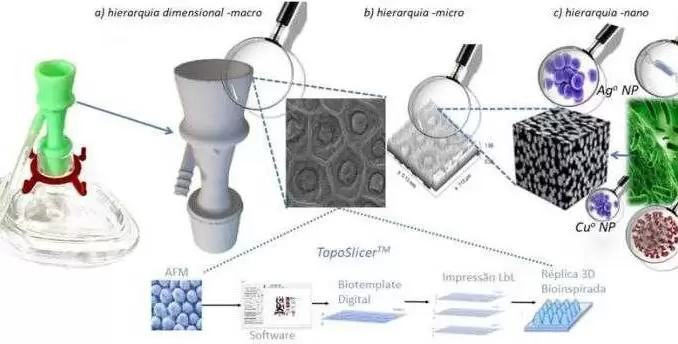
Views: 22
– Emergency actions, medium-term confrontation and in the post-pandemic scenario of covid-19
Minapim by Hernan Valenzuela: Proactive and innovative processes are part of the results in the activities of the academy, but immediate solutions demand a greater effort. This is the case for solutions developed in the Pandemic period for the human health area.
The Federal University of Pernambuco – UFPE, brings a good example of proactivity and creativity in the proposal of emergency applications to human health. Proposing the use of 3D printing of functional materials, the Photonic and Bioinspired Nanodevices Architecture Group, a member of the CNPq Research Groups Directory, is currently working with a set of actions related to the COVID-19 Pandemic, in three axes:
1) emergency with incremental innovations;
2) radical medium-term innovations and
3) innovations for the post-pandemic scenario, in the prevention of new cycles – each action associated with an approved and ongoing project.
As an emergency action, in view of the increase in cross-contamination involving health professionals and projections of insufficient number of mechanical respirators available for patients in need of intensive care, based on emergency solutions from European countries, in particular Italy, the proposed solution refers to the printing of “respirator-free” devices for emergency use in the absence of mechanical fans.
To enable the use of low-cost solutions, this action is an integral part of the Support Network for health care, diagnosis of COVID-19 and production of personal protective equipment in Pernambuco, under the general coordination of Prof. Maira Pitta, with resources from the Regional Labor Office.
In this group, a subproject coordinated by Prof. Petrus Santa Cruz aims to mitigate cross-contamination by contaminated exhaled aerosol, which normally prevents the use of Venturi-type valves in COVID-19 patients, to enable its emergency use as a low-cost solution, based on previous experience in additive manufacturing. of functional materials at the LandFoton Laboratory and Ponto Quantum Nanodevices, units of the Group, now using DLP (Digital Light Processing) technology, to scale the proposed solution.
For medium-term confrontation, the “Interdisciplinary Network for the Development of Self-Decontaminating Materials with Active Passive Hierarchical Structures aimed at confronting the Pandemic COVID-19 and other outbreaks” (Created within the scope of the CAPES Public Notice 09/2020, of “Prevention and combating outbreaks, endemics, epidemics and pandemics ”).
The recently approved project, coordinated by Prof. Petrus at PPG Química, makes possible the structuring of an interdisciplinary team of researchers from UFPE of four PPGs: Chemistry, Computer Science, Materials Science and Biological Sciences, and has 30 CAPES scholarships (12 for doctorate and 18 for post-doctorate) ).
This interdisciplinary group seeks HR training with a focus on P, D & I of self-decontaminating materials, and development of these materials combining micro / nanotechnologies and computing for the development of materials with hierarchical structures for 3D printing by DLP, as mentioned in the previous axis, but with manufacturing additive of devices with these new materials associated with bioinspired surfaces in structures of Brazilian biodiversity.
Previous experience in the subject has already resulted in defenses of theses and dissertations, articles and patent deposits. The post-pandemic axis COVID-19 refers to actions to strengthen the immune system in a scenario in which the population had a considerable reduction in exposure to the sun due to the necessary confinement process, with the support of a project approved in the SibratecNANO public notice network. Nanodevices and Nanosensors.
Since the important correlation of the role of vitamin D in the prevention of acute respiratory tract infections was established, reinforced with the publication “Vitamin D supplementation to prevent acute respiratory tract infections: systematic review and meta-analysis of individual participant data” in 2017, which counted with the participation of researchers from 23 medical reference centers, it is necessary to pay attention to reducing the population’s exposure to the sun, since solar UV radiation is the catalyst for the production of this vitamin.
The importance of vitamin D replacement in this scenario has become even more evident with the publication this September of the article – Association of Vitamin D Status and Other Clinical Characteristics With COVID-19 Test Results , published by Meltzer et al. in the journal JAMA Network Open. 2020; 3 (9): e2019722 (doi: 10.1001 / jamanetworkopen.2020.19722).
The strategy used in the ongoing project is non-pharmacological intervention, aiming to contribute to increasing the protection of the population against recurrence of severe acute respiratory syndromes in a scenario of post-pandemic vulnerability. The innovation allows to stimulate the individual production of cutaneous vitamin D catalyzed by the sun, monitored by the individual himself, by a device being developed within the scope of the technological innovation project approved in the Network of Nanodevices and Nanosensors, with the counterpart of the company OUTLIER Tecnologia da Informação LTDA and partnership with the technology-based company Ponto Quântico Nanodevices, the proposal’s innovation hub, based at Positiva – UFPE’s Technological Innovation Center.
The projects under execution in the first and third axis above have the administrative support of the UFPE Development Support Foundation (FADE), and the CAPES project, in the second axis, is part of the joint actions involving the training of human resources in the consolidation of the line of printing of functional materials (Printrônica), making UFPE a pioneer in this new area of additive manufacturing, prominent in industry 4.0. health
Ref: D O I: 10.1371 / journal.pone.0200918 – Printable nanocomposites of polymers and silver nanoparticles for antibacterial devices produced by DoD technology. PLoS One, v. 13, p. e0200918, 2018. Barrera, N .; Guerrero, L .; Debut, A .; Santa-Cruz, P. A.
Related patent: BR10201901483, Deposit: 07/18/2019. Hybrid printable cover of bioactive material with structural inhibition of plaque formation. 2019. Santa-Cruz, P. A .; Barrera, N .; Guerrero, L .; Souza, E. S .; Queiroz, R. S.
Related software: TopoSlicer (2018), Computer Program for the Generation of Bioinspired Digital Molds from AFM for bio-structures, INPI registration number: BR512018001308-2. Santa-Cruz, P. A .; Melo, S. B .; Queiroz, R. S .; Souza, E. S.
Source: UFPE
Related Article: COVID 19- The importance of vitamin D³ confirmed